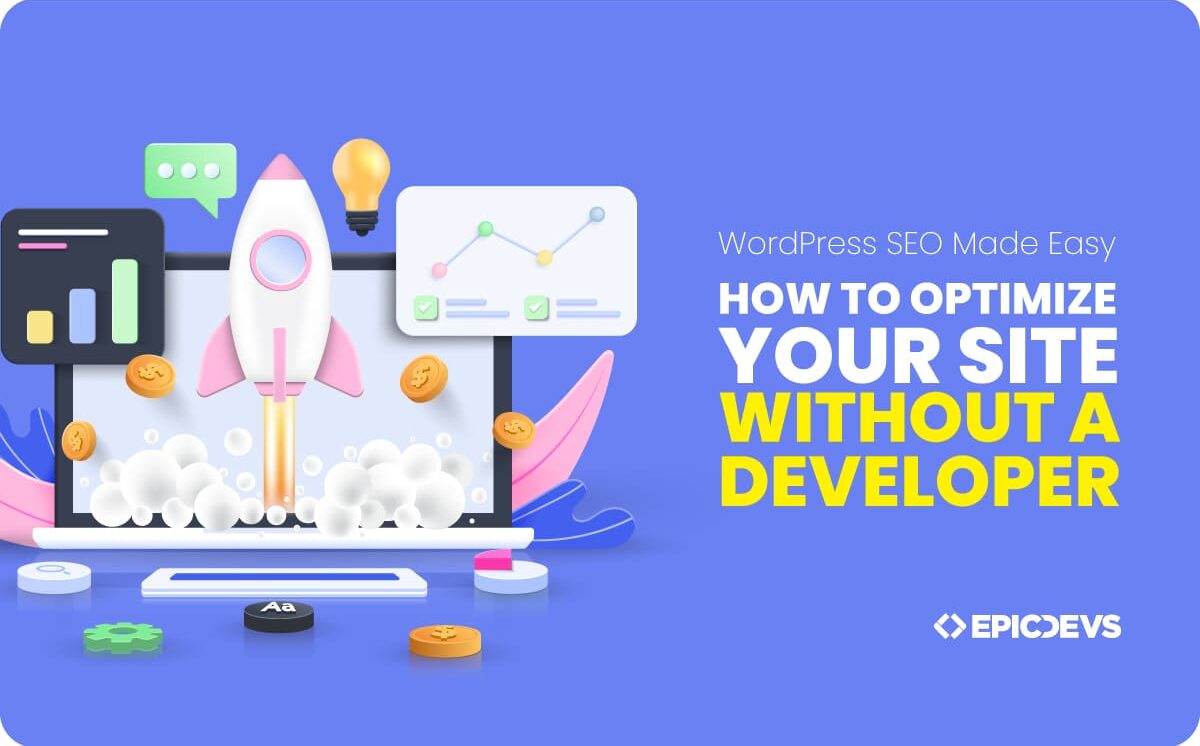If you run a small business, manage a blog, or use WordPress for other reasons but aren’t a tech whiz, SEO can feel like a whole new world where you aren’t quite sure if what you’re doing is making any difference. The good news? You don’t need to be a developer or have coding skills to improve your site’s SEO! With just a few easy steps, you can make a big difference in how your site performs in search results – all from your WordPress dashboard.
Today, we’ll walk you through some simple SEO tasks you can tackle on your own, like installing an SEO plugin, improving site speed, optimizing meta tags, and organizing your internal links to boost your site’s ranking.
1. Get Started with an SEO Plugin
One of the best ways to dip your toes into SEO is by installing an SEO plugin. These handy tools simplify a lot of the work for you handling things like meta tags, sitemaps, and more, so you don’t have to worry about the technical stuff.
Top SEO Plugins for WordPress:
- Yoast SEO: This is a go-to for many WordPress users. It helps you optimize keywords, check readability, and automatically generates XML sitemaps to help search engines find your pages.
- All in One SEO Pack: Another fantastic choice, this plugin offers features like meta tag customization, social media integration, and basic SEO tweaks to help your site rank better.
How to Install an SEO Plugin:
In your WordPress dashboard, go to Plugins > Add New. Type in the name of the plugin (like Yoast or All in One SEO), hit Install, and then activate it. The plugin will walk you through setting up SEO for your site, step by step.
If you’re not confident in your technical abilities, don’t worry. These plugins are super beginner-friendly and will guide you through optimizing your content with clear, easy-to-understand instructions.
2. Optimize Your Meta Tags
Meta tags are key to helping search engines and users understand what your page is about. How? Think of meta tags as labels or short descriptions for each page on your website. When search engines like Google crawl your site, they look at these to quickly understand the content of your page and determine if it’s relevant to what people are searching for. They also play a huge role in whether people click on your site when it shows up in search results.
What Are Meta Tags?
- Meta Title: This is the headline that shows up in search results. It should be short, include relevant keywords, and give a clear idea of what the page is about.
- Meta Description: This is the short blurb below the title in search results that explains what your page offers. A good meta description should be engaging and encourage people to click.
How to Optimize Meta Tags Using Yoast SEO:
- When editing a post or page in WordPress, scroll down to the Yoast SEO section.
- Enter a focus keyword – this is the main term you want the page to rank for in search engines.
- Yoast will help you create an optimized meta title and description. It even checks the length so you stay within the ideal range (50-60 characters for titles and 150-160 characters for descriptions).
By fine-tuning your meta tags, you’ll help both search engines and users understand your content better, which can lead to more clicks and better rankings.
3. Speed Up Your Website
Nobody likes a slow website – especially search engines like Google. If your site takes too long to load, not only will users leave, but your search rankings could suffer too. The faster your site, the better your chances of ranking higher and keeping visitors around.
Don’t believe us? 53% of mobile users will leave a page if it takes more than 3 seconds to load, and for each additional second of load time past the first, the bounce rate increases by 32%. Talk about scary. (Google) (Envisagedigital)
Simple Ways to Boost Your Site Speed:
- Optimize Your Images: Large images can slow down your pages. Tools like TinyPNG or ShortPixel can compress your images without sacrificing quality. You can also install a plugin like Smush to automatically compress images as you upload them.
- Enable Caching: Caching stores a temporary version of your site, making it load faster for returning visitors. Plugins like W3 Total Cache or WP Super Cache can help with this.
- Use a CDN: A Content Delivery Network (CDN) distributes your website content across multiple servers worldwide, meaning faster load times for users no matter where they are. Popular CDNs like Cloudflare or StackPath are worth checking out.
With a faster site, you’ll keep both your visitors and search engines happy, which can lead to better rankings and more traffic.

4. Organize Your Internal Links
Internal linking is all about connecting the dots within your site. By linking to other relevant pages or posts, you help visitors navigate your site more easily and show search engines how your content is structured. Plus, you make sure the content you’re putting out is actually getting read!
Why Internal Links Matter:
- For Search Engines: They help search engines understand the hierarchy and structure of your content, which can improve your SEO.
- For Users: Internal links guide users to more related content, keeping them on your site longer, thus improving engagement.
How to Add Internal Links:
- As you write new posts or pages, find natural opportunities to link to other parts of your website. For example, if you’re writing a post on “How to Improve WordPress Speed,” you might link to a page about “Top WordPress Plugins for Performance.”
- Use clear, descriptive anchor text (the clickable text) that tells visitors what they’ll find if they click on the link. Pro tip: avoid vague phrases like “click here.”
Adding internal links is an easy way to boost SEO while helping visitors find more of your content.
5. Don’t Forget About Mobile Optimization
With more than half of all web traffic coming from mobile devices, making sure your site is mobile-friendly is incredibly important (Google). And, if your site isn’t mobile-friendly, you’re not just giving your users a poor experience, you’re also giving Google a reason to rank you lower. This is because Google’s mobile-first indexing means that how your site performs on mobile directly affects how it ranks in search results.
How to Ensure Your Site is Mobile-Friendly:
- Responsive Design: Make sure your WordPress theme is responsive, which means it automatically adjusts to different screen sizes. If you’re not sure, Google’s Mobile-Friendly Test can help you check if your site works well on mobile.
- Optimize for Speed on Mobile: Like we saw before, mobile users expect fast loading times, so using the image compression and caching tips mentioned earlier is even more important for your mobile visitors.
Final Thoughts
You don’t need to be a tech expert to optimize your WordPress site for SEO. By following the tips we’ve mentioned and doing your own research, you can give your site a big boost in search rankings – all without needing to touch a single line of code.
But, if you still need help taking your WordPress SEO to the next level, EpicDevs is here to help. From site audits to custom optimizations, we’ll guide you through every step of the way. Contact us today to get started!
